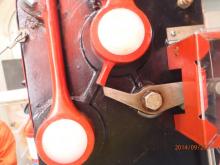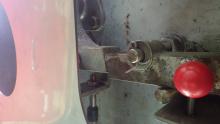The International Convention for the Safety of Life at Sea (SOLAS), 1974 details minimum standards for the construction, equipment and operation of ships, to ensure their safety.
Lifeboats
Lifeboats are essential for crew safety in an emergency. They must be checked and maintained regularly and before an inspection. Routine checks and maintenance must be done by properly trained crew members and following the manufacturer’s instructions.
Our surveyors will require additional lashings before entering the lifeboat.
Further information is in Marine Notice 02/2014.
When checking lifeboats regularly and before an inspection, make sure to:
- Check the release system and interlock is set correctly.
- If fitted, check the indicators are clear and in correct position.
- Keep the instructions secured in the boat.
- Check the lifeboat’s painter release is operable.
- Check the engine has enough fuel and is de-watered as necessary.
- Turn the lifeboat on and make sure there is no start delay.
- Test the propulsion allows it to go ahead and astern and that it can be steered in all directions.
- Keep the engine starting batteries maintained and in good condition.
Lifeboats may be found deficient if any of these cannot be properly demonstrated. If this happens, the ship will be detained until a lifeboat technician can fix it.
- Lifeboat hook and release systems
Most lifeboats in use have a hook and release system that are either:
- Off-load: the boat is floating and the weight must be off the hooks before they can be opened.
- On-load: the hooks can be opened with the load of equipment and people inside the boat.
Both types have to be regularly checked, maintained and used properly so that there is no risk that the lifeboat will fall from any height with people onboard.
- Hydrostatic override



- Interlock

The release levers may look to be in position and reset, but the deficiency occurs when each of the devices in the release system are not maintained in their original condition.
- Morse cables
Morse cables (similar to brake cables on a bicycle) are common connections between the hydrostatic unit and the interlock, and also between the release lever(s) and the hooks.
Problems that can occur with the morse cable:
- Moisture can damage cables and cause rust.
- Loose or missing cable clamps can cause the morse cable to break.
These issues can cause:
- mechanisms to become stiff to operate and need excessive force
- one hook to release
- one hook to release before the other.

Communication equipment
Ship radio systems are important tools for safe navigation and communication in an emergency.
When checking communication equipment regularly and before an inspection, make sure to check:
- The MF / HF DSC by making a test call and getting an answer—make a record of it.
- The VHF DSC by making a test call and getting an answer—make a record of it.
- The Inmarsat C system by sending a link test—make a record of it.
- The appropriate navarea is selected for reception of maritime safety information—and records are maintained.
- All communications can be properly operated on reserve power.
- All radios are installed properly and the power supply is in good condition.
- That operators are familiar with the equipment.
- The 406MHz emergency position indicating radio beacon is stored properly and regularly tested in case of emergency.
If any of these are found to be deficient, your ship may be detained.
Emergency generators
As with the communications equipment, the emergency source of power to other critical systems is very important.
As part of our standard port State control inspection, we will generally request a demonstration of the emergency generator. This will usually be simply a no-load, manual start or if fitted, auto-start based on a simulated black-out condition. The test requested will not impact upon shipboard operations. We find examples where either the generator will not start or if started, will not provide power as required.
When checking the emergency generators regularly and before an inspection, make sure to check:
- The generator starts and it is in good condition.
- The means of starting are working and in good condition.
- The required onboard crew are familiar with running the emergency power supplies.
- When running, that the generator supplies the right voltage and frequency.
- The safety management system onboard includes the above steps for regular checks.
If any of these are found to be deficient, your ship may be detained.